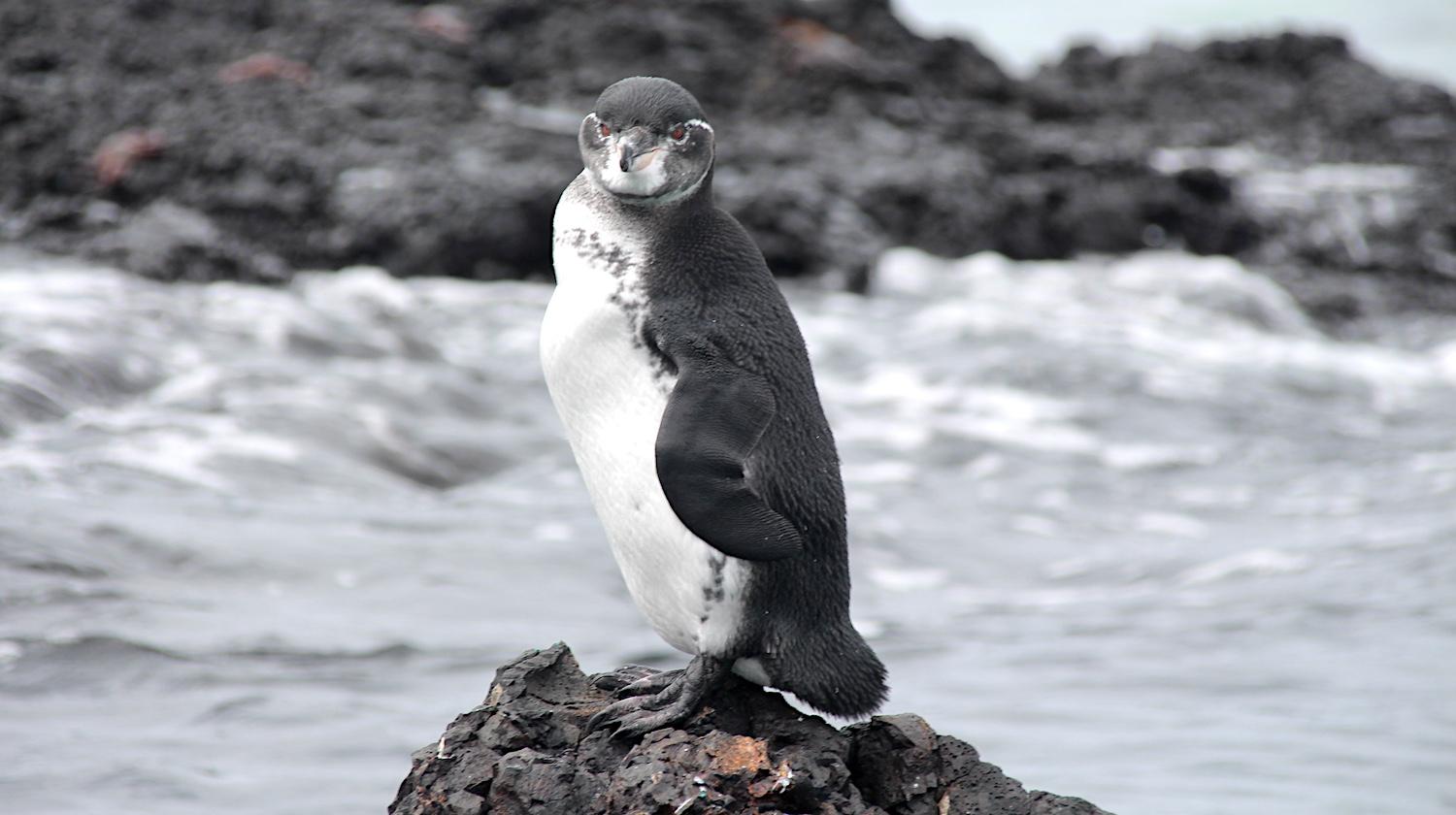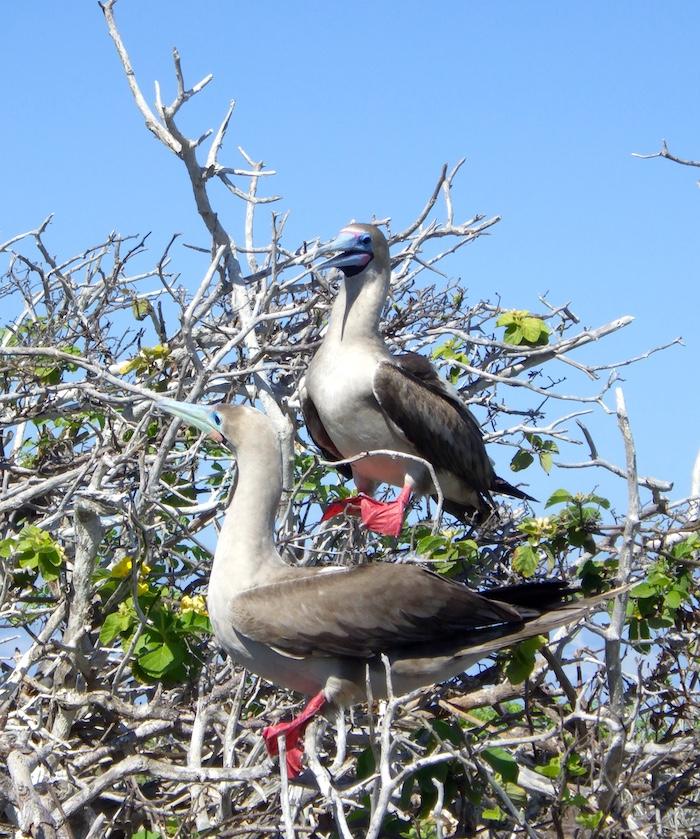
Research into the spread of microplastics shows Galápagos penguins are obtaining them/Karly McMullen
Microplastics Turning Up In Galápagos Penguins
Insights Into Food Web Pollutants
By Kurt Repanshek
Darting about and changing directions about as quickly as a school of fish, the Galápagos penguins seemed gregarious and with unlimited energy. Despite technically being birds, they swam amazingly well, quickly weaving and bobbing as they dodged our small group enjoying the marine wonders of Galápagos National Park off the coast of Ecuador.
The smallest species of penguins, these also are the only ones found north of the equator, enduring the warm climate thanks to the cold flows of the Humboldt and Cromwell currents. Standing only about 19 inches tall and weighing just about five-and-a-half pounds at maturity, the birds are extremely capable. They can reach speeds of almost 22 mph in the water while hunting, and can live to 20 years. But they are an endangered species, with fewer than 2,000 individuals, in large part because of feral cats, rats, and how El Nino is impacting their prey base, and potentially because of plastics.
Microplastics — tiny beads, shards, and threads of plastic, sometimes in a kaleidoscope of colors — are found the world over, from mountaintops in the Rockies to marine waters. They are the result of the breakdown of plastic bottles and bags, fleece jackets, and even buoys that point to lobster traps, vessel anchors, and channels. According to one study, more than 2 million pounds of microplastics, the equivalent of 123 million plastic bottles, settle on national parks and other public lands in the Western United States each year.

The penguins, which spend much of their time on or in the water surrounding the Galápagos Islands, consume fish that have accumulated microplastics in their bodies/Kurt Repanshek file
They also find their way into fish, birds, reptiles, and mammals, and they are showing up in places often envisioned as pristine and protected because of their remoteness. Like the Galápagos Islands, located roughly 600 miles of the coast of Ecuador. There, recent studies have detected microplastics in the scat of penguins.
"The reason I focused on the penguins is because I thought it was important to pick a charismatic animal that people can kind of can look to and see the impacts and see how how microplastics might be affecting wildlife," said Karly McMullen, whose master's degree in oceans and fisheries from the University of British Columbia led her to the islands to examine the impact of microplastics in the food web. "The penguin was kind of a perfect, quirky, charismatic animal that wobbles around on the surface and kind of stumbles over rocks and whatnot."
As such, it can serve as a posterchild of sorts to warn of the spread of microplastics, she said Tuesday during a phone call from her office.
McMullen's research into microplastics and the penguins was overseen by Dr. Juan José Alava and Dr. Evgeny A. Pakhomov of the Institute for the Ocean and Fisheries at the university. While it's known that microplastics are just about everywhere, the scientists wanted to measure their impact on marine organisms.
To explore the issue, they traveled to the Galápagos Islands in October 2021 to collect seawater, fish that the penguins feed on, zooplankton, and penguin scat in their search for plastics. Data from the samples were then run through a modeling program that helped explain how the microplastics got into the penguins.
That modeling pinpointed a "rapid increase in microplastic accumulation and contamination across organisms until around year five of the organism’s life, at which point the rate of uptake shifted to a gradual increase and eventual plateau," a release about their research explained.

It's unknown how the microplastics are affecting the penguins/Karly McMullen
Because the penguins are endemic to the Galápagos Islands, the scientists thought they'd be perfect for their research.
"There's so many unique animals in the Galápagos, so many amazing, charismatic animals to choose from there. The penguins, who have such a unique story of being the only tropical penguin that exists and lives on molten rock on the equator. So there's that element," said McMullen. "And then the fact that they reside only on the islands in their colonies. It's easier to track the pollutants specifically that are in the Galápagos, rather than an animal that might travel far distance off the coast. We wanted to really target Galápagos."
The scientist recalled the large mass of microplastics she found during the dissection of a milkfish, which the penguins feed on.
"One fish I opened up and all the colors of the rainbow [were there]. There's purple fibers, red, pink, blue, something you would not expect to see in a stomach," she said.
What the scientists weren't able to do was monitor whether the penguins were taking in microplastics from the air.
"Other research has shown that we as human beings are finding microplastics in our lungs and our tissues, so we know that animals can ingest or take in microplastics through the air," said McMullen.
How the microplastics are affecting the penguins and their endangered status, if at all, is not known. The spectre of microplastics only entered the scientific literature in 2004, according to the scientist. However, studies on lower life forms have identified impacts to reproduction, hormones, energy level, and behaviors, she said.
No dead penguins were found that might have allowed necropsies to determine whether microplastics were accumulating in any specific organs.

It's also not known how microplastics are affecting other iconic species, such as the red-footed boobies, at the islands/Kurt Repanshek file
"For me, it just is not helping the situation," said McMullen. "It might not be what has driven them to this point where they're endangered, but it's certainly not helping."
While the research did not focus on how the microplastics got into the Galápagos' environment, there are some obvious sources.
"A major one is fishing in the area. In the Galápagos we know that there's a lot of illegal unreported, unregulated fishing," she said. "And not just in the Galápagos, but around the world. That's a major source of microplastic pollution. At the moment microfibers, from textiles and clothing, is being talked about a lot more in policy. And that's because as we do our laundry and as we wear and tear, there are tons and tons and tons of microfibers just flowing right into the ocean because they're not being trapped in our wastewater management. So that's another big one. And then, of course, you have just the breaking down of other larger plastics, which is either local sources or from farther away, we have the Great Pacific Garbage Patch, breaking down microplastics all the time. So the sources are plenty."
At one point in her research, McMullen observed buoys in a marina that were covered with algae that fish fed upon. Could that have been another source? She wondered.
While the research was focused specifically on Galápagos penguins, the findings raise the question of whether the islands' other iconic species, the blue-footed and red-footed boobies, Nazca boobies, frigate birds, marine iguanas, sea turtles, sea lions, and lesser known species also are being contaminated.
Hernán Vargas, who participated in the research, said the discovery of microplastics in the penguins and their prey "is undoubtedly worrisome because it shows the globalization of this emerging anthropogenic threat for the conservation of the Galápagos, proving that microplastics can reach isolated and protected areas, such as the Galápagos Archipelago, across thousands of kilometers. Plastic pollution may also affect the public health of human residents inhabiting the islands. As a global threat to ecosystems, global remedies are required to solve it.”

Comments
Thank you for a great article on an important subject! I am not sure how we can over come the world wide use of plastics and contain it as it breaks down. Glad there is this research happening in a critical habitat . Great pictures!